Western counties roofing provide green roofing systems across all sectors.
Green Roofing is an increasingly popular alternative to traditional roofing systems, as well as being visually pleasing they create green spaces, particularly in urban areas bringing nature and wildlife back.
Green roofs consist of several layers of a growing medium planted over a waterproofed roof surface. The type of green roof and plants selected are determined by several factors but mainly by the type of roof, size and structure. Regardless of the type of green roof all green roofs contain insulation and drainage systems within the layers. Both flat and sloped roofs are suitable foundations for green roofs but due to weight constraints park like roofs remain limited to larger buildings.
Aside from being aesthetically pleasing, there are several benefits of green roofs:
- They are good for the environment; they absorb pollution and reduce rainwater.
- Green roofs are extremely durable and prolong the life of the roof for as long as 50 years by providing protecting against UV and weather damage.
- They reduce energy costs but providing insulation, keeping the building warm in winter months and cool in summer months.
- They provide a useful recreational space for roof gardens and terraces.
The only disadvantage of roof gardens is the initial outlay is much higher than traditional roofing systems.
Green roofs are mainly covered with hardy, pest and disease resistant and fireproof plants that grow quickly and are not invasive. When plants are selected there are three main types of green roofs, extensive, intensive and biodiverse.
Extensive green roofs are suitable for all types of roofs where green roofs are appropriate. A lightweight hardy mat of sedum vegetation is installed requiring little maintenance providing an ecological alternative to roofing ballasts such as paving and gravel Our fully trained green roof installation engineers can build and install systems of any size, quickly and cost effectively.
Intensive green roof are landscapes recreational areas on a roof, usually multifunctional and accessible. Depending on the design, this type of green roof requires a significant depth in soil as well as a lot of maintenance, making anything possible from, lawns to trees including patios and ponds.
Biodiverse green roofs are becoming increasingly popular in the UK. They are designed to replicate natural habitats for one or multiple species by providing food, nesting opportunities or resting places for creatures, such as spiders, beetles, butterflies, birds, etc. Due to the soil and nutrients required some maintenance is required.
There are different waterproofing systems available to suit the individual project criteria for the green roof, its landscaping options, weight loading limits, performance and durability requirements.
